I usually begin talks on my book Higher Education Accountability with a discussion of why accountability pressures now are stronger than ever for much of nonprofit higher education. Not surprisingly, one of the key reasons that I discuss is the rising price tag of a college education. I usually get at least one question from audience members in every talk about the extent to which administrative bloat in higher education is driving up college prices. I have written before about how difficult it is to pin the rising cost of providing a college education on any given factor, but I am diving in deeper on the administrative bloat concern in this post.
First, let’s take a look at trends in administrative expenditures and staffing over the last decade or two. Here are charts on inflation-adjusted per-FTE expenditures for instruction, academic support, institutional support, and student services between 2003 and 2013 (courtesy of Delta Cost Project analyses). The charts show that spending on student services and academic support increased faster than both inflation and instructional expenditures, while institutional support expenditures (the IPEDS expenditure category most closely associated with administration) increased about as fast as instructional expenditures.


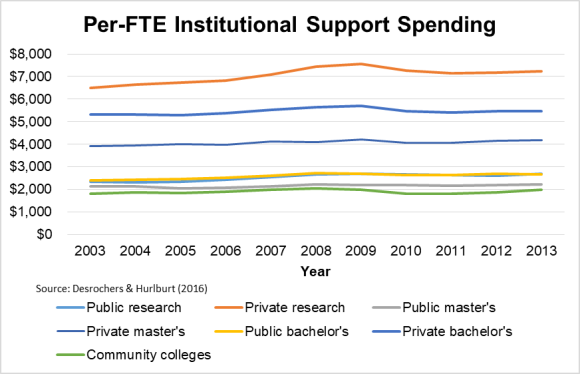
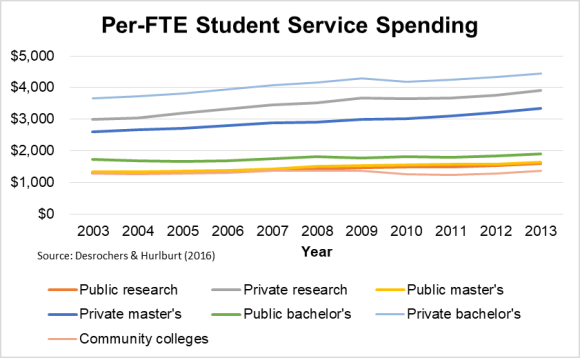 Turning to staffing trends, I again use Delta Cost Project data to look at the ratios of full-time faculty, part-time faculty, administrators, and staff per 1,000 FTE students. In general, the ratio of full-time faculty and administrators per 1,000 students held fairly constant across time in most sections of higher education. However, the ratio of part-time faculty and professional staff members (lower-level administrators) increased markedly across higher education.
Turning to staffing trends, I again use Delta Cost Project data to look at the ratios of full-time faculty, part-time faculty, administrators, and staff per 1,000 FTE students. In general, the ratio of full-time faculty and administrators per 1,000 students held fairly constant across time in most sections of higher education. However, the ratio of part-time faculty and professional staff members (lower-level administrators) increased markedly across higher education.

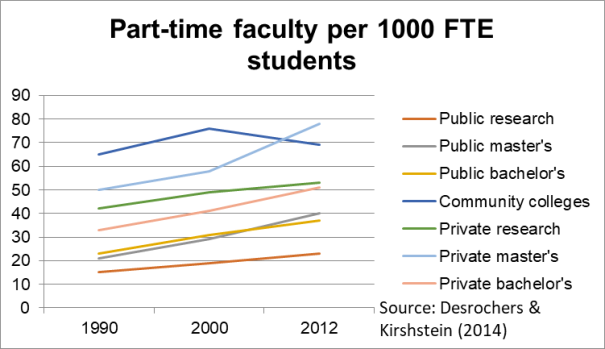
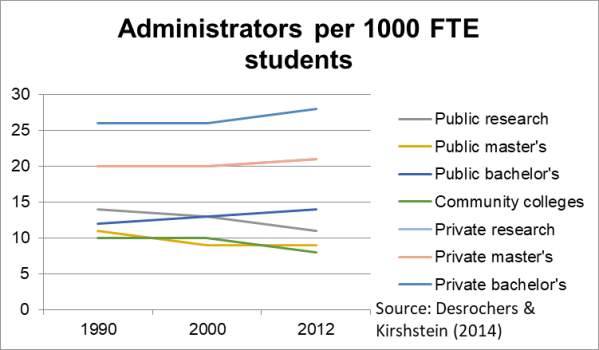
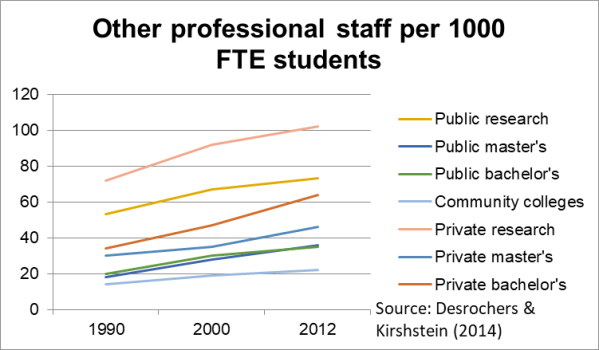 The data suggest that there has not been a massive explosion of high-level administrators, but there has been substantial growth in low- to mid-level academic support and student services staff members. What might be behind that growth in professional staff members? I offer two potential explanations below.
The data suggest that there has not been a massive explosion of high-level administrators, but there has been substantial growth in low- to mid-level academic support and student services staff members. What might be behind that growth in professional staff members? I offer two potential explanations below.
Explanation 1: Students need/want more services than in the past. As most colleges have enrolled increasingly diverse student bodies and institutions respond to pressures to graduate more students, it’s not surprising that colleges have hired additional staff members to assist with academic and social engagement. Students have also demanded additional services, such as more staff members to support campus diversity initiatives. (Lazy rivers and climbing walls could factor in here, but there are limited to such a small segment of higher education that they’re likely to be a rounding error in the grand scheme of things.)
Explanation 2: Staff members are doing tasks that faculty members used to do, which may not necessarily be a bad thing. A good example here is academic advising. Decades ago, it was far more common for faculty members to advise undergraduate students from their first year on. But over the years, professional academic advisers have taken on these responsibilities at many campuses, leaving faculty members to advise juniors and seniors within a major. To me, it seems logical to allow lower-paid professional advisers to work with first-year and second-year students, freeing up the time of higher-paid faculty members to do something else such as teach or do research. (I also have a strong hunch that professional advisers are better at helping students through general education requirements than faculty members, but I’d love to see more research on that point.)
In summary, there are lots of gripes coming from both faculty members and the public about the number of assistant and associate deans on college campuses. But most of the growth in non-faculty employees is among lower-level student and academic affairs staff members, not among highly-paid deans. There is still room for a robust debate about the right number of staff members and administrators, but claims of massive administrative bloat are not well-supported across all of higher education.
It’s hard to believe that a faculty member is writing this, but I do feel that most administrators do serve a useful purpose. As I told The Chronicle of Higher Education in a recent interview (conducted via e-mail while I was waiting for a meeting with an associate dean—I kid you not!), “Faculty do complain about all of the assistant and associate deans out there, but this workload would otherwise fall on faculty. And given the research, teaching, and service expectations that we face, we can’t take on those roles.”

Before 1990 universities didn’t have much of an IT infrastructure. Now the are probably the largest admin departments on most campuses. Then there is grants and contracts regulatory compliance, also miniscule pre 1990 but exploded since. The question should be more like why is admin spending not higher than it is? What was cut to pay for IT and compliance?
These are really good points. On the other hand, secretarial support is much less of a thing than it was decades ago because faculty and administrators can do more of their own communication thanks to e-mail. I’d love to see more research delving into this.
I’m not deeply embedded in this area, but I think many folks would see it as non-obvious to examine administrative costs on a per-student basis. On one hand it is obvious on further reflection that many kinds of administrative costs should go up when enrollment goes up, but I do wonder whether those costs should be as closely tied to enrollment as hiring of instructors ought to be.
I’m struck by the way everyone hates “administrators” in the abstract, but no one has a specific plan about the administrators who should actually be fired: https://jakeseliger.com/2015/10/16/when-there-are-too-many-administrators-which-ones-do-you-fire
The problem is not simply rising salary costs per se but that all these extra administrators (senior and mid-level) create new rules and regulations and required reports and committee meetings that add costs to the rest of the organization. It’s become like India’s famous “paper Raj.”
I think there is an issue here in the definition of terms. To some faculty, any “office worker” in higher ed who is not directly engaged with students in the classroom might be considered “administrative,” not just deans and associate deans, etc…, but also the academic advisors, student support service providers, and all of their “administrative assistants.” So, I think for many people, administrative bloat doesn’t only refer to upper level management, but to all of the “other professional staff” as well.
Each school has its own story. It’s impossible to look at this data and then look at my school and say I concur. We’ve added a huge layer of senior admins in the last 9 years, and they all are paid (minimum) double what faculty are paid. Meanwhile, we have also grown our faculty numbers, but our adjunct pool is bigger than ever, too.
That’s a good point. I focus my analyses across broader sectors of higher education, which certainly doesn’t mean that some campuses are not adding large numbers of deans and deanlets.
Excellent post Robert! I concur with both your explanations and have a few things to add:
1. One thing we hear from institutions is that compliance is another factor that’s driving additional student services staffing
2. Advancement and associated functions (e.g., marketing and communications) is another factor driving administrative staff is growth, particularly among public research universities receive less state and federal support and so have to raise more $ privately. (Similar to the comment about IT as a big factor in the rise)
3. One other thing the Delta cost project revealed (using IPEDS data) is the precipitous drop in non-professional staff (technical, clerical, craft, maintenance, etc) from 114 FTE per 1000 Students in 1990 to 69 FTE in 2012 (39% drop)
At the CC level, faculty should do most of the advising. Not enough advisors and faculty have a closer connection to the students.
Good stuff! Could we see the graphs with the y-axis logged?